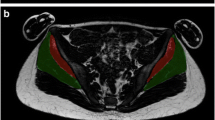Abstract
Purposes
To verify the relationship between muscle volume and muscular strength of different cross-sectional areas (CSAs) of the gluteus maximus and medius, and to clarify the effective evaluation index.
Methods
Twenty healthy adults were enrolled in this cross-sectional study. Magnetic resonance images were evaluated, and CSAs of the gluteus maximus and medius were calculated. Calculation sites were the peak CSA, lowest end of the sacroiliac joint CSA, and just above the femoral head CSA. Muscle volume and muscular strength were measured. The correlation between muscular CSA, muscle volume, and muscular strength was verified using Pearson’s correlation coefficient (p < 0.05). One-way analysis of variance and the Tukey–Kramer test were used to verify differences in each CSA (p < 0.05).
Results
A significantly positive correlation was found between muscular CSA, muscle volume, and muscular strength of both muscles (p < 0.05). For the gluteus maximus, the muscular CSA calculated just above the femoral head showed a significantly larger value than that calculated at the lowest end of the sacroiliac joint (p < 0.05). For the gluteus medius, the peak CSA and muscular CSA calculated at the lowest end of the sacroiliac joint were significantly larger than that calculated just above the femoral head (p < 0.05).
Conclusions
The maximum CSA of the gluteus maximus was found just above the femoral head and that of the gluteus medius was near the lowest end of the sacroiliac joint; hence, CSAs should be calculated at these sites. The CSA reflected muscle volume and strength.


Similar content being viewed by others
References
Ahedi H, Aitken D, Scott D, Blizzard L, Cicuttini F, Jones G (2014) The association between hip muscle cross-sectional area, muscle strength, and bone mineral density. Calcif Tissue Int 95:64–72. https://doi.org/10.1007/s00223-014-9863-6
Bullock-Saxton JE, Wong WJ, Hogan N (2001) The influence of age on weight-bearing joint reposition sense of the knee. Exp Brain Res 136:400–406. https://doi.org/10.1007/s002210000595
Flack NA, Meikle GR, Reddy M, Nicholson HD, Woodley SJ (2012) Hip abductor muscle volume in women with lateral hip pain: a case-controlled study. Surg Radiol Anat 34:847–855. https://doi.org/10.1007/s00276-012-0970-7
Fukunaga T, Miyatani M, Tachi M, Kouzaki M, Kawakami Y, Kanehisa H (2001) Muscle volume is a major determinant of joint torque in humans. Acta Physiol Scand 172:249–255. https://doi.org/10.1046/j.1365-201x.2001.00867.x
Grimaldi A, Richardson C, Durbridge G, Donnelly W, Darnell R, Hides J (2009) The association between degenerative hip joint pathology and size of the gluteus maximus and tensor fascia lata muscles. Man Ther 14:611–617. https://doi.org/10.1016/j.math.2008.11.002
Grimaldi A, Richardson C, Stanton W, Durbridge G, Donnelly W, Hides J (2009) The association between degenerative hip joint pathology and size of the gluteus medius, gluteus minimus and piriformis muscles. Man Ther 14:605–610. https://doi.org/10.1016/j.math.2008.11.002
Hartzman S, Gold RH (1989) MRI atlas of the musculoskeletal system. Martin Dunitz Ltd., London
O’Brien TD, Reeves ND, Baltzopoulos V, Jones DA, Maganaris CN (2009) Strong relationships exist between muscle volume, joint power and whole-body external mechanical power in adults and children. Exp Physiol 94:731–738. https://doi.org/10.1113/expphysiol.2008.045062
Rasch A, Byström AH, Dalen N, Berg HE (2007) Reduced muscle radiological density, cross-sectional area, and strength of major hip and knee muscles in 22 patients with hip osteoarthritis. Acta Orthop 78(4):505–510. https://doi.org/10.1080/17453670710014158
Seeger LL, Lufkin RB (1989) MRI atlas of the musculoskeletal system. Martin Dunitz Ltd., London
Suetta C, Aagaard P, Rosted A, Jakobsen AK, Duus B, Kjaer M, Magnusson SP (2004) Training-induced changes in muscle CSA, muscle strength, EMG, and rate of force development in elderly subjects after long-term unilateral disuse. J Appl Physiol 97:954–1961. https://doi.org/10.1152/japplphysiol.01307.2003
Thorborg K, Petersen J, Magnusson SP, Hölmich P (2010) Clinical assessment of hip strength using a hand-held dynamometer is reliable. Scand J Med Sci Sports 20:493–501. https://doi.org/10.1111/j.1600-0838.2009.00958.x
Tracy BL, Ivey FM, Jeffrey Metter E, Fleg JL, Siegel EL, Hurley BF (2003) A more efficient magnetic resonance imaging-based strategy for measuring quadriceps muscle volume. Med Sci Sports Exerc 35:425–433. https://doi.org/10.1249/01.MSS.0000053722.53302.D6
Uemura K, Takao M, Sakai T, Nishii T, Sugano N (2016) Volume increases of the gluteus maximus, gluteus medius, and thigh muscles after hip arthroplasty. J Arthroplasty 31:906–912. https://doi.org/10.1016/j.arth.2015.10.036
Zacharias A, Pizzari T, English DJ, Kapakoulakis T, Green RA (2016) Hip abductor muscle volume in hip osteoarthritis and matched controls. Osteoarthr Cartil 24:1727–1735. https://doi.org/10.1016/j.joca.2016.05.002
Acknowledgements
DH would like to express his appreciation to his English teacher Mr. Takao Kobayashi, and gratefulness to everyone in the radiology department of the Niigata Bandai Hospital. We would also like to thank Editage (http://www.editage.jp) for English language editing.
Funding
This study did not receive any funding or financial support.
Author information
Authors and Affiliations
Contributions
DH: Data collection or management, analysis, and manuscript writing/editing. IM: Protocol/project development. NI: Manuscript writing/editing. DM: Protocol/project development. YS: Data collection or management. YH: Data analysis. HS: Data analysis. YD: Data collection or management. NE: Protocol/project development.
Corresponding author
Ethics declarations
Conflict of interest
The authors declare that they have no conflict of interest.
Ethical approval
This study was approved by Niigata Bandai Hospital’s ethics committee (Approval number 54). All procedures performed in studies involving human participants were in accordance with the ethical standards of the institutional and/or national research committee and with the 1964 Helsinki declaration and its later amendments or comparable ethical standards.
Informed consent
Informed consent was obtained from all individual participants included in the study.
Rights and permissions
About this article
Cite this article
Homma, D., Minato, I., Imai, N. et al. Investigation on the measurement sites of the cross-sectional areas of the gluteus maximus and gluteus medius. Surg Radiol Anat 41, 109–115 (2019). https://doi.org/10.1007/s00276-018-2099-9
Received:
Accepted:
Published:
Issue Date:
DOI: https://doi.org/10.1007/s00276-018-2099-9




